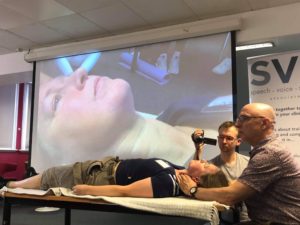I can take it…
Manual therapy, myofascial release, massage, and the host of other touch-based interventions often rely on the perception of the clinician’s expertise to gauge pressures. Patients will often give up power to the therapist in order to (try to) feel better, though isn’t that an odd arrangement? Allowing someone else to decide what is best for you is the norm in a traditional medical model, but what about manual therapy models? Is there evidence that more aggressive, deeper pressures are more effective than lighter pressures? Such questions are difficult to answer as I’ve yet to read a research study that actually looks at this question. Some people prefer heavier pressure while others prefer lighter pressures. There is some sense of natural selection at play with regards to pressures and the patients that each of us sees in our practice, for if I become known as a deep pressure sort of guy then I will have a tendency to attract people who feel that type of pressures would work best for them. If one preferred a lighter touch then there is a good chance that this person would never darken my door. If we believe that the sample that we see as patients/clients indeed represent a random sample then we might be deluded into thinking that we do indeed do what is best, which would include the type of pressures that we use. But this is not the case.
I strongly believe in a therapeutic partnership when I see someone for care. This includes full informed consent to what I propose to do and includes fully explaining (and getting permission for) what I propose to do. I’m also not very fond of allowing my patient to drift off, allowing me to do what’s best. I NEED a full partner in the relationship, which includes the establishment of pressure markers. I try to avoid questions such as, “Is this pressure OK?”, preferring instead questions such as, “Does this pressure feel like it might be helpful? If not, is there anything about what I’m doing that feels like it could be harmful?” While these last few questions can be closed-ended questions (yes/no answers), they require a lot of thought on the part of the patient, at least in terms of the amount of responsibility that is expected of them in a session.
I speak at great length about how we determine safety and efficacy, form the aspect of patient-perspectives, in my seminars. But for now…her is a video to talk about this a bit more.
Cheers,
Walt Fritz, PT
Foundations in Myofascial Release Seminars
Please check out my seminar offerings at this link. I now teach seminars across the globe to professionals of all types.
I am a proud member of the Medbridge Massage team of educators. I have 8 online courses, all presented from my updated, science-informed model of myofascial release. Take advantage of some pretty great discounts with a 12-month package of viewing, learning and CEUs with unlimited viewing of not only my (pretty great) courses but also over a dozen of the top educators in the massage profession. Approved for CEUs for all US MTs. Use the discount code FRITZmassage for the $49/year price by using this link: Medbridge Massage.

I can also offer some pretty great discounts to SLPs, PTs, and OTs through Medbridge Education. Click the image below here to have the discount applied.



Sorry, comments are closed for this post.